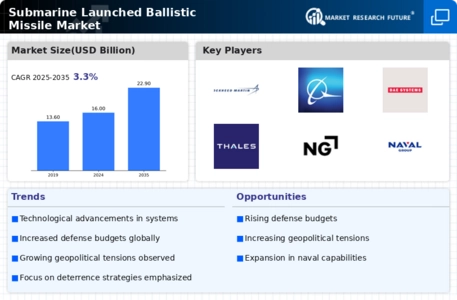The Submarine Launched Ballistic Missile (SLBM) Market is characterized by a complex interplay of technological advancements, geopolitical tensions, and strategic partnerships among key players. As of October 2025, the market appears to be driven by the increasing demand for advanced deterrent capabilities and the modernization of naval forces across various nations. Major companies such as Lockheed Martin (US), Northrop Grumman (US), and Thales Group (France) are at the forefront, focusing on innovation and strategic collaborations to enhance their competitive positioning. Lockheed Martin (US) emphasizes its commitment to developing next-generation missile systems, while Northrop Grumman (US) is actively pursuing partnerships to bolster its technological capabilities. Thales Group (France) appears to be concentrating on integrating advanced digital technologies into its offerings, thereby shaping a competitive landscape that prioritizes technological superiority and strategic alliances.
The business tactics employed by these companies reflect a concerted effort to optimize supply chains and localize manufacturing processes. The SLBM market is moderately fragmented, with several players vying for market share, yet the influence of key players remains substantial. This competitive structure suggests that while there is room for smaller entities, the dominance of established firms is likely to shape market dynamics significantly. The collective strategies of these companies indicate a trend towards consolidation and collaboration, which may further enhance their operational efficiencies and market reach.
In August 2025, Lockheed Martin (US) announced a strategic partnership with a leading defense contractor to co-develop a new class of submarine-launched missiles. This collaboration is poised to leverage both companies' technological expertise, potentially accelerating the development timeline and enhancing the capabilities of the new missile systems. Such strategic moves are indicative of a broader trend where companies seek to pool resources and knowledge to maintain a competitive edge in an increasingly complex market.
In September 2025, Northrop Grumman (US) unveiled its latest advancements in missile guidance systems, showcasing a significant leap in precision targeting capabilities. This development is crucial as it aligns with the growing emphasis on accuracy and reliability in military operations. By investing in cutting-edge technology, Northrop Grumman (US) not only strengthens its product offerings but also positions itself as a leader in the evolving landscape of SLBM technology.
In July 2025, Thales Group (France) launched a new initiative aimed at enhancing cybersecurity measures for its missile systems. This initiative reflects an acute awareness of the increasing threats posed by cyber warfare and the necessity for robust defense mechanisms. By prioritizing cybersecurity, Thales Group (France) is likely to gain a competitive advantage, appealing to nations that prioritize the integrity of their defense systems in an era of digital warfare.
As of October 2025, the SLBM market is witnessing a shift towards digitalization, sustainability, and the integration of artificial intelligence in defense systems. Strategic alliances are becoming increasingly vital, as companies recognize the need to collaborate to innovate and enhance their technological capabilities. The competitive differentiation in this market is likely to evolve from traditional price-based competition to a focus on innovation, advanced technology, and supply chain reliability, suggesting a future where agility and technological prowess will be paramount.

















Leave a Comment